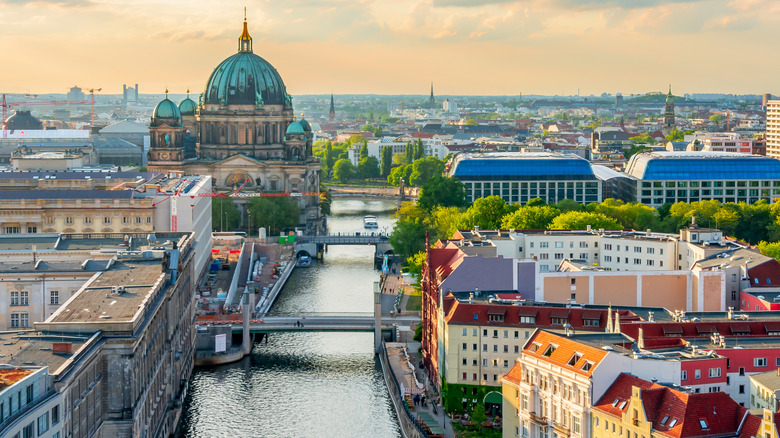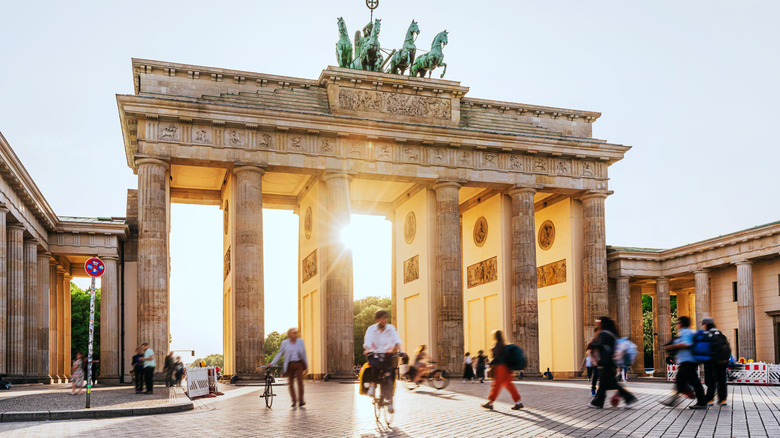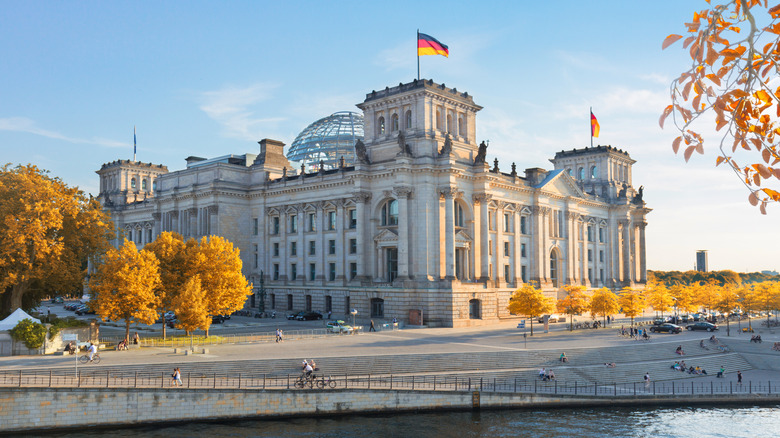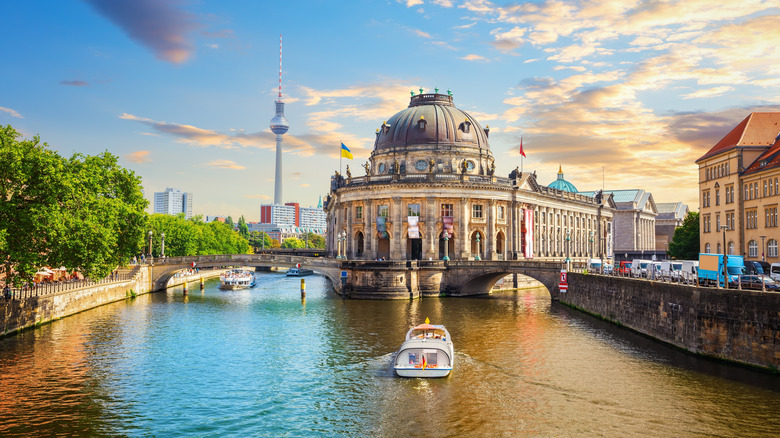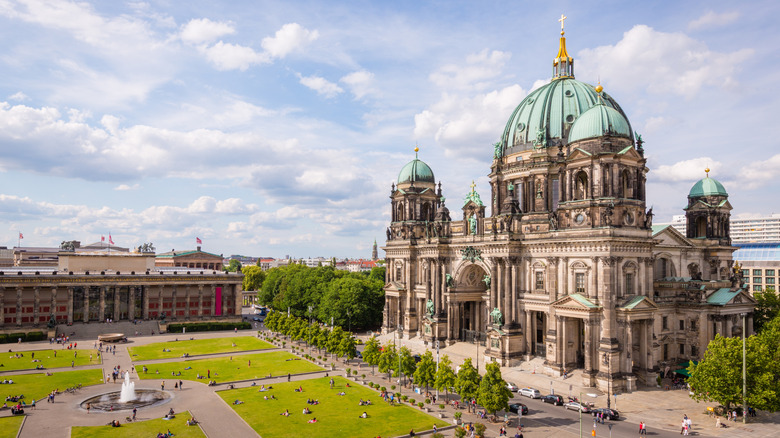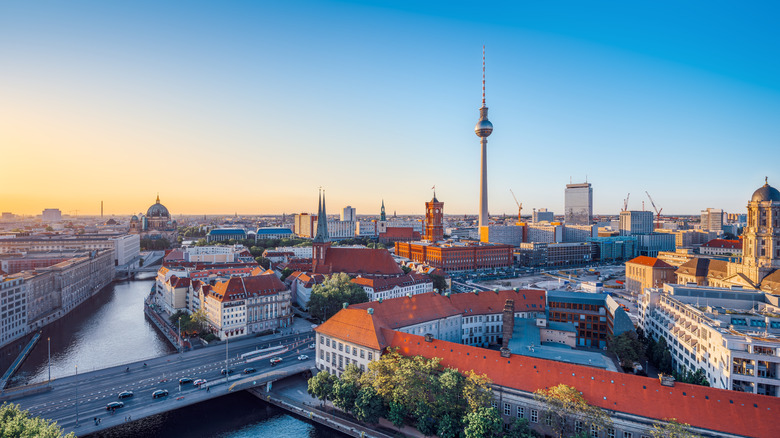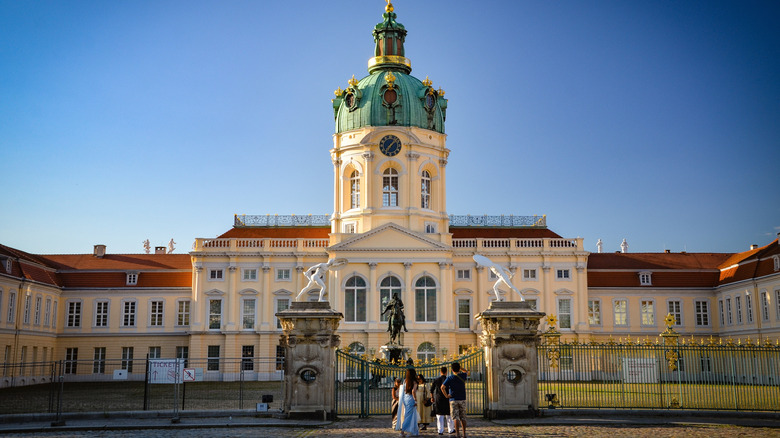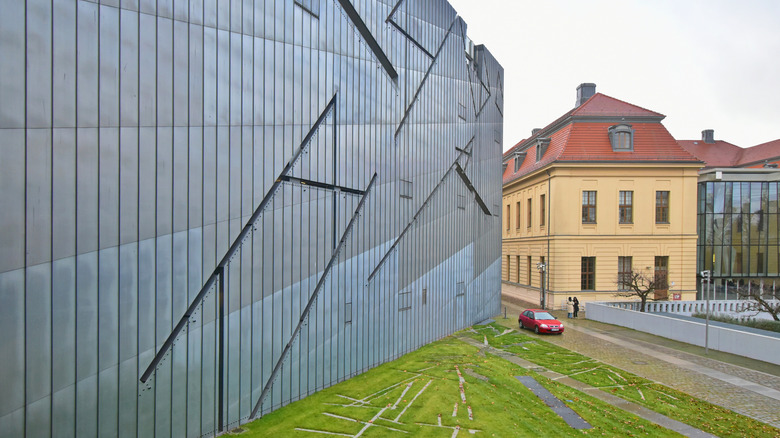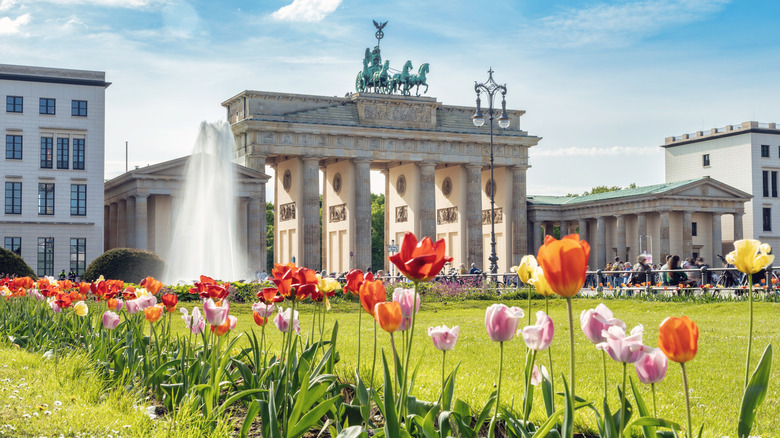10 Of Berlin, Germany's Major Tourist Attractions You Should Never Skip
Berlin, Germany, is a city of contrasts. Its very history is entwined with dualities — just look at the ruins of its infamous giant wall that separated East and West Berlin from 1961 to 1989. It's also a place of time-honored traditions that resonate with history while providing a canvas for edgy and up-and-coming artists, hip neighborhoods, graffiti, and some of Europe's most famous nightlife — it's a bonus for night owls that there's no regulated closing time! Rick Steves even says this popular European city is best explored after dark.
While today, Berlin thrives with artsy vibes, great eats, and world-class museums, the city also acknowledges the legacy of its role during the Nazi regime as the capital of the Third Reich. Since World War II and the Holocaust, Germany has sought to both honor the memory of those who lost their lives during this terrible time while also trying to move on from its dark past.
A visit to this city is a unique insight into where history meets the present. You'll find wonderfully expansive public parks, elegant shopping areas, holiday markets, and famous landmarks in an energetic city with a rapidly growing population that could reach four million people by 2036. You might even wish to take a walk on the wild side in an underground world of animatronic monsters hidden below a courtyard. Needless to say, this city has a lot to offer. Below, you'll find 10 of Berlin's most famous tourist attractions that you should make sure to check out.
The East Side Gallery and the Berlin Wall
Berlin found itself in the middle of a dispute between democratic Western forces and the Communist Soviet Union (USSR) immediately after World War II. The wartime allies of the U.S., U.K., France, and the USSR divvied administration of Germany into four occupation zones, with the USSR controlling the east and the other three nations controlling the west. A similar agreement also divided the city of Berlin into four occupation sectors, despite Berlin sitting in what was technically Soviet territory. In the summer of 1961, record numbers of people began fleeing Communist East Germany for West Germany. To stop this, East Germany constructed the Berlin Wall literally overnight, between August 12 and 13, 1961, with miles of barbed wire. The wall eventually took the form of a giant concrete barrier, extending 96 miles, separating the country and keeping families apart. A symbol of division — and when it was torn down, unity — the Berlin Wall is a critical piece of global history.
Located on the River Spree, just a block away from Uber Arena, sits an open-air gallery that doubles as a memorial. Berlin is well-known for its street art — add the Urban Nation Museum for Urban Contemporary Art to your itinerary if you're a fan of graffiti — so it's fitting that a Berlin Wall memorial is the work of dozens of artists. Known as the East Side Gallery, a stretch of concrete more than 4,300 feet long showcases paintings added between 1989 and 1990 by more than 100 international artists. As they're outside, the works weather and fade over time, but the Berlin Wall Foundation takes care to preserve and restore them for generations to come. The Wall Museum is also a worthwhile stop for a multimedia experience tracing the history of the infamous boundary.
The Brandenburg Gate and Tiergarten
Arguably Berlin's most famous monument, the Brandenburg Gate has served many purposes throughout its existence — all of which are fittingly symbolic. The triumphal arch was built in the late 18th century, and it was soon topped by the "Quadriga," a bronze chariot pulled by four horses. This iconic sculpture became even more meaningful after Napoleon had the whole thing moved to Paris in 1806 after his forces defeated Prussia; less than a decade later, victorious Prussian forces were able to return the Quadriga to its rightful spot. It was then all but destroyed during World War II, so the version you see today is a 1958 replica. (If you happen to find yourself in The Hague, in The Netherlands, you can visit the only remaining remnant, a horse's head, at the Mauritshuis.)
In 1961, the Brandenburg Gate became part of a restricted zone between East and West Berlin. When the Berlin Wall was toppled in 1989, more than 100,000 people turned up at the Brandenburg Gate to celebrate; it has remained a symbol of unity ever since. On New Year's Eve, it's a sight to behold as fireworks explode overhead.
The gate also sits on the eastern edge of Tiergarten, a green space in the heart of the city, much like New York City's Central Park. Tiergarten covers more than 500 acres and boasts numerous picturesque walking paths, gardens, and cultural venues like Haus der Kulturen der Welt — a uniquely shaped art center that Berliners have coined the "pregnant oyster." A set of 68 bells plays every Sunday during the summer, and you can also stroll through the Gas Lantern Museum, which features nearly 100 examples of these historic street lights from around Germany and other parts of Europe in a free display.
The Reichstag Building
Completed in 1894, the Reichstag Building was set to become a focal point of German history. As a building meant to house a legislative body, it's central to politics and lawmaking, and it has seen its fair share of use, neglect, and rebirth. In 1918, the German Republic was formally introduced, making the monarchy a thing of the past. And in early 1933, the building burned down — Hitler blamed a Communist uprising, and, through subsequent constitutional maneuvers, he set the stage for total control via the Third Reich. During World War II, the Reichstag Building was thoroughly bombed. But, as a testament to Germany's philosophy that its past should inform the future, it took around a decade to renovate the building following reunification in 1989, and it reopened in 1999. During the renovation period, it was even the subject of a monumental conceptual artwork by acclaimed artists Christo and Jeanne-Claude, who wrapped the entire building in more than one million square feet of synthetic fabric for two weeks.
Today, the Reichstag Building is home to the Deutscher Bundestag, the lower house of the German parliament. Its contemporary glass dome lets light into the parliamentary chamber inside, and it also accompanies visitors who head to the rooftop to take in the architecture and the great views it affords of Tiergarten and the city beyond. Advanced registration is required to visit, but admission is free. There's also a 20-minute audio guide that walks you through the building's history, and you can reserve the rooftop, award-winning fine dining at Kaefer-Dachgarten Restaurant, too. Just be aware that, in addition to the Brandenburg Gate and other popular tourist attractions in Berlin, the Reichstag Building is a destination where you're most likely to get pickpocketed, so keep your belongings close!
Museum Island
Along the River Spree, amid Berlin's historic center of Mitte, sits the beloved cultural hub of Museum Island. A UNESCO World Heritage Site, the whole place is a historic treasure that in itself holds art and objects that tell stories of past millennia. Museum Island hosts five 19th- and early 20th-century museum buildings, each of which was designed to reflect the type of collection it preserves and shares. The Altes Museum, or Old Museum, was a trailblazer; when it opened its doors in 1830, it was the first museum open to the public in Berlin. Today, it houses a marvelous collection of antiquities. And in 1855, what is now known as the Neues Museum (New Museum) opened originally as the Royal Prussian Museum, and today it holds an astonishing collection of ancient Egyptian and Nubian art — including the famous 3,000-year-old bust of Queen Nefertiti.
Museum Island's newest exhibition space is the James Simon Gallery, opened in 2019 as a central entrance hall with contemporary style. From there, you can head to the Alte Nationalgalerie, which is one of Museum Island's famed art museums, home to Impressionist masterpieces and other 19th-century works. The Bode Museum takes you back further through art history with collections of Byzantine artworks, coins, Renaissance paintings, and more. Finally, of the original five museums, the Pergamonmuseum (Pergamon Museum) is a renowned destination for ancient Greek and Roman art, with its massive collection spread out also among the Altes and Neues Museums. While the Pergamonmuseum undergoes major renovations — it's slated to reopen in 2027 — you can visit a 360-degree digital panoramic experience created by artist Yadegar Asisi to immerse yourself in the ancient city of Pergamon in 129 C.E.
Berlin Cathedral
Another must-visit spot on Museum Island is Berlin Cathedral, also known as Berliner Dom. Overlooking the River Spree on one side and the pleasantly green Lustgarten on the other, the cathedral is a treat. Rick Steves' top tip to get the best views of Berlin's breathtaking architecture is to follow the river, and the cathedral is among the finest sights you'll see from the water. Its history can be traced to 1465, when a smaller chapel stood in its place, and over the next couple hundred years, the building grew. Then, Frederich the Great saw potential in a brand new building, which opened in 1750. The church was again rebuilt at the turn of the 20th century, opening in 1905, and this is the cathedral we see today. Unlike some must-see historic structures that took hundreds of years to build, its history goes back far, but the building we see today is relatively new. It once had an even larger dome, which was destroyed during World War II, but even the reconstructed version is a marvel.
The cathedral originally contained three churches: the Sermon Church, the Baptismal and Matrimonial Church, and the Memorial Church. The latter was torn down in 1975. A visit to the subterranean Hohenzollern Crypt is a unique experience to see ornate tombs of Germany dynastic rulers. Check out the grand Imperial Staircase, gaze up at the enormous Sauer organ, and even stop for a coffee with a view of the River Spree at the basement café. And of course, don't miss a climb up to the dome for a stunning panoramic view of Berlin. It's a 270-step climb, but it's worth it!
Berlin TV Tower and Alexanderplatz
An unmistakable feature of the Berlin skyline, the city's TV tower, known as Berliner Fernsehturm, is both a landmark and an attraction well worth a visit for stunning panoramic views. Soaring over Alexanderplatz, the largest square in Germany, the tower offers a unique vantage point from the city center. And because Alexanderplatz is also a major retail, entertainment, and transportation hub, it's easy to get here via all forms of public transportation. In the month leading up to Christmas, one of the best Christmas markets in Europe takes over the square with dozens of stalls, a winter village, and a roller skating rink. And if you fancy a throwback cruise around town, hop aboard a Nostalgietour in a vintage vehicle, leaving from Alexanderplatz.
Berlin TV Tower's observation deck provides 360-degree views from 670 feet off the ground. The next floor up hosts the revolving Sphere Restaurant, a unique dining experience with a menu created by local acclaimed chef Tim Raue. A ticket reservation should be booked in advance for a seating, with options ranging from entry and timed seating starting at €28.50 (which includes admission to the observation deck) to options at varying price points that include breakfast, lunch, or a 4-course dinner. Alternatively, head to the Sphere Bar for craft cocktails and tasty nibbles, including Berlin's famous currywurst, with a range of entry ticket options, including one that boasts an immersive VR experience.
Checkpoint Charlie
At the intersection of Friedrichstraße and Zimmerstraße, a diminutive little building, a stack of sandbags, and a large post topped with a photograph of a soldier mark the spot where some of the most tense Cold War moments occurred when the boundary between East and West Germany still separated Berlin. Known as Checkpoint Charlie, the crossing in the Berlin Wall was controlled by American forces, and when the wall was torn down, people were able to finally pass through it for the first time in nearly three decades. Today, you can visit the original site, which includes a replica checkpoint post — a very popular spot for photo ops.
Adjacent to Checkpoint Charlie is the Mauermuseum, which highlights the history of the border crossing within the greater context of East and West Germany and the broader Cold War. (The Mauermuseum is sometimes called the Wall Museum, which differs from the Wall Museum at the East Side Gallery.) You can also learn about the many — often fatal — escape attempts that occurred while the wall still stood, and through original documents, photographs, and other artifacts, learn about what life was like on both sides between 1961 and 1989. Adult admission to the Wall Museum is €18.50, and there are additional €5 fees if you'd like to add on an audio guide or permission to take photos. It's free to visit the replica outdoor area, which sits right in the middle of Friedrichstraße.
Charlottenburg Palace and Park
The area that is now modern Germany historically consisted of numerous, evolving independent states, one of which was Prussia. Ruled by the Hohenzollern dynasty since the 15th century it became the Kingdom of Prussia in 1701 when Frederick I declared himself its first king. And for ascending rulers, nothing but the most decadent palaces will do. Located in the district of Charlottenburg — today, a thriving gallery and shopping district — Charlottenburg Palace was begun in 1695 and finished in 1699; it immediately became a symbol of Prussian grandeur and a favorite residence for generations of monarchs. In 1740, Frederick the Great added a whole new wing, too, which included awe-inspiring Rococo halls. So, the next time you're plotting which enchanting real castles around the world to visit, make sure Charlottenburg is on your list!
Much of the original Charlottenburg Palace sustained heavy damage during World War II, but following meticulous restoration efforts, it has been rebuilt and continues to be a popular tourist attraction for its artistic and ornate interiors. The beautiful formal gardens are also a draw, with design roots going back to 1695. Within this expansive setting, you'll also find a charming folly known as the Belvedere, which houses a collection of fine porcelain. There's also the somber yet monumental mausoleum of Queen Luise, who died in 1810. And you can visit the New Pavilion, a bright, boxy, intimate summer residence inspired by Italian villas, which was constructed in the 1820s.
Gendarmenmarkt
While Alexanderplatz may hold the distinction of Germany's largest square, Gendarmenmarkt is often considered Berlin's most attractive. The central figure, quite literally, is a marble statue of Frederich Schiller, one of the nation's most famous poets. The square is also known for its surrounding architecture, especially two large buildings with towers known as the German Cathedral and the French Cathedral, plus Konzerthaus Berlin, a concert hall. It's worth noting that the "cathedrals" aren't really churches at all — they were designed with matching cathedral-like domes to create visual harmony in the square, but they actually house museum exhibitions. Französischer Dom hosts the Huguenot Museum, and Deutscher Dom features an exhibition about the history of Germany's parliament.
The square received a huge renovation in 2025 to improve drainage and make the stone surface fully accessible to visitors with all abilities. The area comes alive with music in July, thanks to a program called Classic Open Air, which brings classical music to the picturesque steps of the Konzerthaus. And in the winter, Gendarmenmarkt is a hub for holiday cheer as a Christmas market takes advantage of the postcard-worthy backdrop.
Jewish Museum Berlin and the Holocaust Memorial
In 2001, acclaimed architect Daniel Libeskind's vision for the Jewish Museum Berlin opened formally to the public, a labyrinthine, zig-zagging design based on a concept that he called "Between the Lines." Accessed underground via an entrance in an adjacent historic building called the Old Building, Libeskind's design has a bold, almost disruptive appearance without any clear way in or out that can be seen from the exterior. The experience inside the building itself is disorienting, somber, and even oppressive, with tall "voids" purposely designed to be stark and unsettling, with the addition of dramatic art installations.
The Libeskind Building holds the core exhibition titled "Jewish Life in Germany: Past and Present," which walks visitors through the rich history of Jewish culture. The baroque-style Old Building hosts a program of rotating exhibitions. Taking some advice from Rick Steves, whose smart approach to booking tickets in advance to European museums is sure to enhance your experience, consider reserving your tickets early. Admission to the core exhibition, plus the children's museum, is free. Time slots often sell out, though, so you can book up to six weeks in advance to find the exact time that fits your itinerary.
Some of the most memorable travel experiences bring you face-to-face with history in a way that is truly sobering. About a half-hour walk north of the museum, don't miss another poignant architectural tribute known as the Memorial to the Murdered Jews of Europe, Germany's primary memorial to the six million Jewish people who were victims of the Holocaust. Stroll through what's known as the Field of Stelae and visit an information center underground.
Methodology
To round up the top 10 destinations for tourists in Berlin, especially those perfect for a first visit, we relied on information from VisitBerlin.de, Berlin.de, IntroducingBerlin.de, plus specific information about local museums and attractions from official websites like Bundestag.de, Staatliche Museen zu Berlin, TV-Turm.de, MauerMuseum.de, SPSG.de, MuseumsPortal-Berlin.de, and JMBerlin.de. For specific data and contextual and historical information, we researched History.com, RickSteves.com, the United State Holocaust Memorial Museum, Britannica.com, and NewWorldEncyclopedia.org. And to make sure we're sharing the best experiences, we relied on the author's personal experiences, plus visitor reviews and ratings from Tripadvisor and Google.
